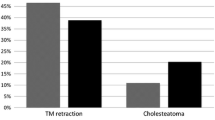Abstract
Mucosa of the middle ear was obtained from the promontory wall in each of 20 patients during cholesteatoma surgery. Specimens were processed for both scanning and transmission electron microscopy. Non-ciliated mucosal cells were commonly found, with most being secretory cells with secretory droplets and microvilli. The patterns of distribution of microvilli on the surface of these cells were variable. The interciliary spaces were stagnated with secretion. Bacilli were present in five cases. Falloff of mucosal cells was common and intercellular spaces were widened. Compound cilia were observed sporadically. Polymorphic nuclear inflammatory cells, macrophages and fibroblasts appeared in the submucosal area. These findings indicate that although remaining adjacent mucosa after removal of cholesteatoma looks free of disease under the operating microscope, it is actually in a diseased condition with impaired mucociliary function. The cells and bacteria seen microscopically may account for postoperative inflammation, thus warranting continued postoperative antimicrobial medication.
Similar content being viewed by others
References
Chao WY, Jin YT (1993) Bone destruction in chronic otitis media with cholesteatoma. In: Nakano Y (ed) Cholesteatoma and mastoid surgery. Kugler & Ghedini, Amsterdam, pp 91–96
Desa DJ (1983) Mucosal metaplasia and chronic inflammation in the middle ear of infants receiving intensive care in the neonatal period. Arch Dis Child 58:24–28
Friedmann I (1956) The pathology of otitis media. J Clin Pathol 9:229–236
Gleeson M, Felix H, Nievergelt J (1991) Quantitative and qualitative analysis of the middle ear mucosal lining in humans. In: Sade J (ed) Basic aspects of the eustachian tube and middle ear diseases. Kugler & Ghedini, Amsterdam, pp 125–131
Hentzer E (1984) Ultrastructure of the middle ear mucosa. Acta Otolaryngol (Stockh) [Suppl 414]:19–27
Huang CC, Yi ZX, Chao WY (1988) Effects of granulation tissue conditioned medium on the in vitro differentiation of keratinocytes. Arch Otorhinolaryngol 245:325–329
Lim DJ, Hussl B (1970) Tympanic mucosa after tubal obstruction: an ultrastructural observation. Arch Otolaryngol 91:585–593
Lim DJ, Shimada T (1971) Secretory activity of normal middle ear epithelium: scanning and transmission electron microscopic observations. Ann Otol Rhinol Laryngol 80:319–329
Lim DJ, Birck HG, Saunders WH (1977) Aural cholesteatoma and epidermization: a fine morphological study. In: McCabe BF, Sade J, Abramson M (eds) Cholesteatoma: First International Conference. Aesculapius, Birmingham, Ala, pp 233–252
Moller P, Dalen H (1981) Ultrastructure of the middle ear mucosa in secretory otitis media. Acta Otolaryngol (Stockh) 91: 95–110
Moriyama H, Honda Y, Huang CC, Abramson M (1987) Bone resorption in cholesteatoma: epithelial-mesenchymal cell interaction and collagenase production. Laryngoscope 97:854–859
Ohashi Y, Nakai Y, Kihara S (1985) Ciliary activity of the middle ear lining in guinea pigs. Ann Otol Rhinol Laryngol 94: 419–423
Ohashi Y, Nakai Y, Esaki Y, Ikeoka H, Koshimo H (1988) Effects of bacterial endotoxin on ciliary activity in the tubotympanum. Ann Otol Rhinol Laryngol 97:298–301
Paparella MM, Sipila P, Juhn SK, Jung TTK (1985) Subepithelial space in otitis media. Laryngoscope 95:414–420
Sade J (1966) Pathology and pathogenesis of serous otitis media. Arch Otolaryngol 84:297–305
Sade J (1967) Ciliary activity and middle ear clearance. Arch Otolaryngol 86:128–135
Sade J, Luntz M (1989) Eustachian tube lumen: comparison between normal and inflamed specimens. Ann Otol Rhinol Laryngol 98:630–634
Sade J, Babyatzki A, Pinkus G (1982) The metaplastic and congenital origin of cholesteatoma. In: Sade J (ed) Cholesteatoma and mastoid surgery. Kugler, Amsterdam, pp 305–319
Shibuya M, Hozawa K, Takasaka T, Yuasa R, Kawamoto K (1987) Ultrastructural pathology of the middle ear mucosa in otitis media with effusion. Acta Otolaryngol (Stockh) [Suppl 435]:90–99
Shimada T, Lim DJ (1972) Distribution of ciliated cells in the human middle ear: electron and light microscopic observations. Ann Otol Rhinol Laryngol 81:203–211
Sloth H, Lildholdt T (1989) Test of Eustachian tube function and ear surgery. Clin Otolaryngol 14:227–230
Tos M, Bak-Pedersen K (1975) Density of goblet cells in chronic secretory otitis media: findings in a biopsy material. Laryngoscope 85:377–383
Yeger H, Minaker E, Charles D, Rubin A, Sturgess JM (1988) Abnormalities of cilia in the middle ear in chronic otitis media. Ann Otol Rhinol Laryngol 97:186–191
Author information
Authors and Affiliations
Rights and permissions
About this article
Cite this article
Chao, W.Y., Shen, C.L. Ultrastructure of the middle ear mucosa in patients with chronic otitis media with cholesteatoma. Eur Arch Otorhinolaryngol 253, 56–61 (1996). https://doi.org/10.1007/BF00176705
Received:
Accepted:
Issue Date:
DOI: https://doi.org/10.1007/BF00176705




